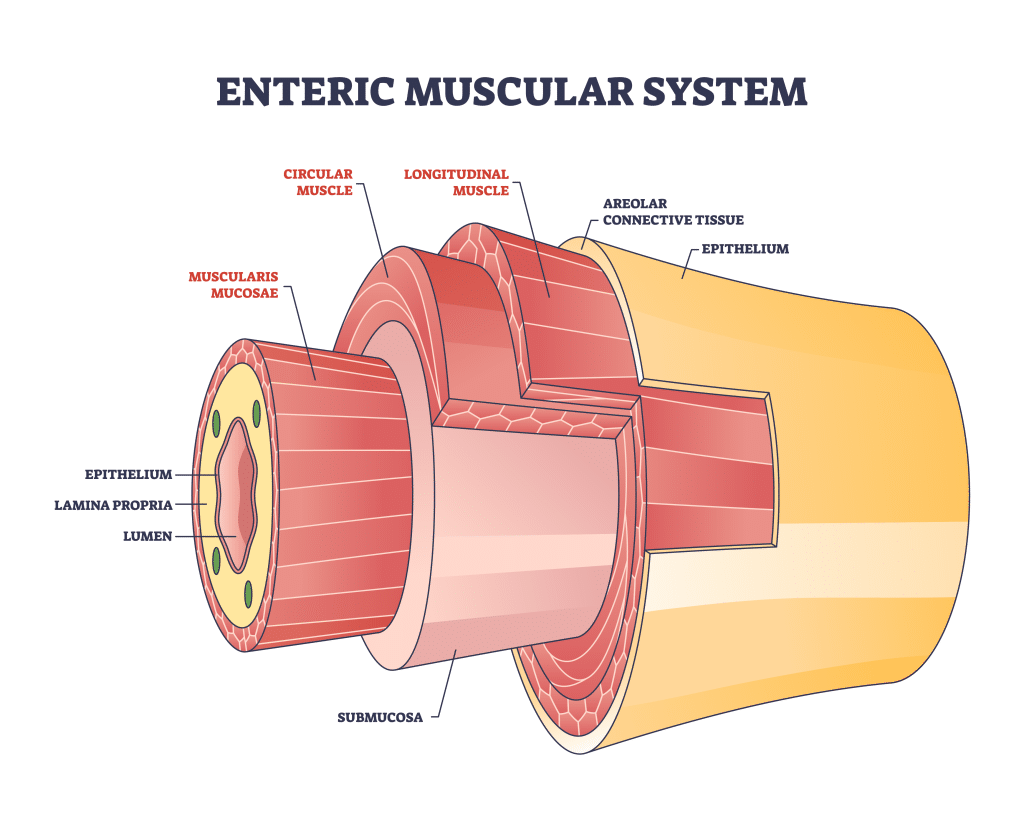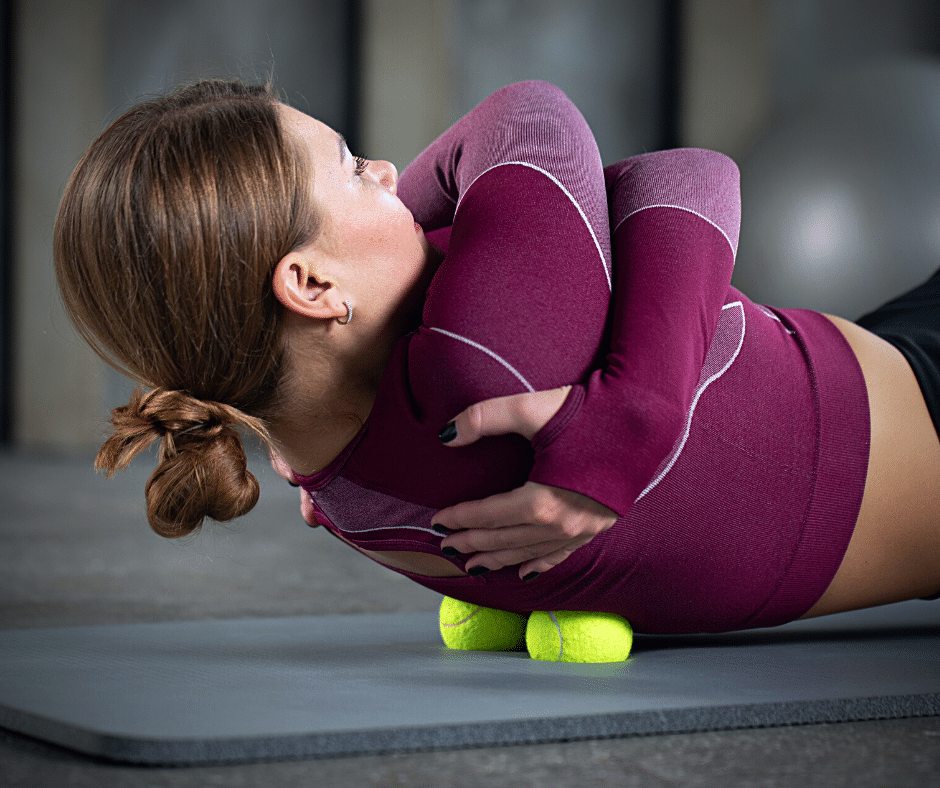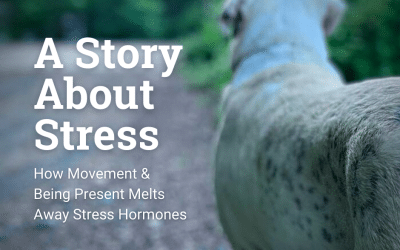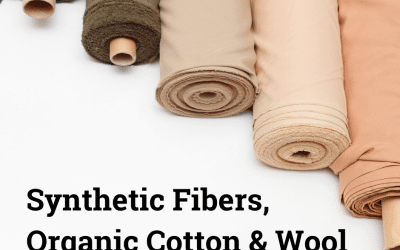Think of our body (our fascia specifically) like clay. To mold clay and make it flexible, you must add water and knead it to make it more malleable. If that clay becomes dry (dehydrated), it becomes hard (calcified). Our fascia is the same. Try stretching hard clay. It doesn’t work out so well, does it?
Now think of our fascia like a sponge in a bowl with water at the bottom. If we apply pressure to the sponge (Fascia), it soaks up the water and becomes more hydrated and saturated with water. This is the same as when we massage our tissue deeply and with sufficient time and intensity.
What is Trigger-Pointing?
Trigger-Pointing is also known as self-myofascial release. It’s simply a form of self-massage literally performed by you. Typically we advise you to utilize effective yet simple tools such as a softball, lacrosse balls, a kettlebell handle, a barbell, Theracane, even massage guns, and scraping tools like guasha blades (which are less deep but are highly effective). There are specialized tools for trigger-pointing from companies like Kabuki Strength, The Trigger-Point Company, SKLZ, Theracane, and others.
Many of us often choose to mindlessly (passively) stretch if we are experiencing some form of pain or tightness, but imagine an elastic band that is twisted up with knots. If you try to stretch that band, it begins to tighten up those specific knots even more so while placing unnecessary & extreme amounts of stress on the non-knotted areas of the band (tissue). This can eventually lead to a tear or even a complete severing of an area that is weakened and dry because the tension should have been applied evenly throughout the entirety of the band (tissue). Knots create weak points rather than evenly distributing tension throughout the band.
Now we actually try to perform stretches every day, you can’t really not stretch, and no, we are not advocating that you stop stretching. It’s really HOW we stretch that has created so many problems among many individuals suffering from chronic and/or acute pain. This is where the corrective exercises come into play. We will have a separate blog diving deeper into the details of corrective exercises/stretches and why to perform them.
We stretch through “corrective exercises” (and dynamic stretching). This method ensures you respect the length-tension relationship throughout the body rather than just stretching without tension. So basically, we activate proper tension to create length through the area that we are intentionally trying to stretch instead of passively holding a stretch, which can create weakness, pulls, and a flaccid structure that lacks muscular engagement and explosive power.
The point of trigger-pointing is to make the fascia more malleable and hydrated and to create space in the fascia so you can perform corrective exercises properly and efficiently and avoid unnecessary pain and injury. Trigger-pointing hydrates and creates a range of motion, whereas passive stretching tugs on dehydrated knots, creating a lack of elastic recoil in the tissues. When you jump right into corrective-style stretching without any form of myofascial release, it can almost seem as if you are pushing against a wall, so to speak. It makes it a lot harder to stretch, play and move properly if you don’t hydrate the fascia first.
As the snowball effect implies, the more we do these foundational habits, the bigger the results. It all starts with trigger-point therapy release. We have to go deep. We have to spend a good amount of time on each trigger point. We have to explore, scan, and slowly apply deep pressure and various angles on these hot spots until that pain fades and we experience a dramatic shift in performance and mobility with each trigger-point release.
Now let’s talk more about hydration and fascia.
What is Fascia?
What is it, and what does it have to do with movement?
The fascial system holds 70 trillion wet cells together by weaving the cells into strong, pliable nets of collagen. Fascia accounts for roughly 60-65% of your body’s total water distribution/ storage. Your tendons, ligaments – all the “tough stuff” – are predominantly made of collagen. If you look at a steak, it is the white spider-web-looking sheath covering meat/tissue.

Our cells are harmoniously living among each other within a three-dimensional spider web of gluey and fibrous moist proteins that are bound together in proper alignment. At least, they should be. Fascia is the Biological Fabric that holds our entire body together, the connective tissue network. According to Thomas Meyers, “Connective tissue includes the blood and blood cells, and other elements not part of the structural net we are examining. Perhaps the closest term would be extra-cellular matrix (ECM), which includes everything in your body that isn’t cellular.” (Myers, “Fascial Fitness: Training in the Neuromyofascial Web”)


There are three main elements of the ECM:
- Fibers: The fibers are strong and pliable and made primarily of 12 types of collagen. Elastin and reticulin separate compartments and bind them together.
- Glue: The glue-like substance found in fascia is made up of heparin, fibronectin, and hyaluronic acid, which are colloidal gels that allow for better sliding & mobility during movement while providing protection for nerve and epithelial cells.
- Water: This fluid surrounds and permeates the cells as means of exchange. The water mixes with the glue (mentioned earlier) to create different materials while keeping the fibers moist and mobile.”
The fibers (collagen) mentioned earlier require a substance known as Glycosaminoglycans (GAGs) in order to bond together like glue. GAGs are mucopolysaccharides. As Meyers states, these are just long words for snot. We are basically held together by mucus. Depending on the variation of chemistry within each of our bodies, the substance can vary from a watery, lubricating fluid to a thick and sticky substance.
When we understand the Length + Tension relationship between fascia, we have to understand the “Length” or “Stretch” aspect first. This is actually not the collagen fibers stretching but the fibers sliding along each other on the Glue of the hydrated GAGs mentioned earlier. (Sbriccoli et al. 2005). If we take the water out of the GAGs, the results simply lead to tearing and making it virtually impossible to stretch (Schleip 2003).
What is Our Goal?
Our goal is to create space, mobility, and fluidity and to systemically hydrate the body on a cellular level. We do this by starting with trigger-point release therapy. Our entire body is one muscle with over 600+ attachments. The body is constantly under length and tension. Our goal is to respect that length/tension relationship between all fascial pathways throughout the body.
A good example of the length/tension relationship is to think of walking like an ‘X’. Reciprocating each step creates a pump throughout the entire body of constant lengthening and tensioning. As the upper body swivels and twists to the right, our right leg comes forward while our left leg goes back, and then vice versa.
As Thomas Meyers suggests, our daily goal should be to wring out the fascia like a sponge. This is why playing, moving, and daily walking are so important. However, in order to walk, move & play efficiently and experience this magnificent pump (and all of its regenerative health benefits) throughout the entire body, we must perform daily trigger-points to hydrate the fascia so the tissues can glide better. Trigger pointing is followed up with corrective exercises to reprogram the length/tension relationship throughout the body so we don’t continue to default to our faulty programming that we have developed over years of dysfunctional habits such as poor training, working, sitting, sleeping, and other various stress habits.
The problem is so many people, like us, are extremely compressed, shortened, twisted, and tilted to one side. So when we walk, we experience pain, inflammation, discomfort, and micro-injuries.
Our goal with this guide is highly focused on getting taller and less compressed and creating a routine that pumps and moves the gallons of interstitial fluid throughout your entire body to lay the foundation of proper biomechanical health for you so you will be fit and ready to take on whatever goals you have!
How Do We Begin?
Trigger-Pointing is actually very simple, but it is also very easy to perform it incorrectly.
- Always Avoid the Spine, your joints, your ribs, and your bones.
- Start by slowly applying moderate-to-very-firm pressure with any choice of trigger-point tool ideal for the spot. You may have to experiment with different tools. (Softball, lacrosse ball, kettlebell handle, etc.)
- Spend at least 2-10 Minutes (5 minutes on average) on each trigger point/muscle. For example, if you are spending 10 minutes left quadricep and 10 minutes on the right, you can break those 10 minutes up with 2 minutes upper/middle/lower quadriceps, etc. Try to spend at least 2 minutes on each specific hot spot or until the pain subsides.
- Slowly work on applying deeper pressure and more intensity over time. You want to search, scan, and explore for hot spots that radiate pain outwards. Once the pain diminishes/lessens, work on exploring the surrounding area, playing with the angles of your joints (like bending your legs or arms), and stretching the fascia to expose and create a deeper, more intense sensation/release.
- The pain should be dull, achy & tender, and not too sharp. The feeling should be around a 7-8/10 on the pain scale. More pain is not always better, but a tickle doesn’t do much, either. It shouldn’t be traumatizing but rather intensely therapeutic. Ideally, you want to hold the pain/hot spot until it subsides. Again, go slow and try not to tense up the rest of your body. Breathe deep and relax.
- Lastly, it really helps to focus on your breath and breathe slowly, around 2-6 breaths per minute through the nose. Avoid breathing in the neck, but rather through the belly, sides, and ribs outwards like a fish with gills, creating expansion in the rib cage/lower chest area rather than tensing up the neck.
Start by trigger-pointing your (click muscle group to watch video):
If we had to choose ONLY 4:
The trigger-point tools you will need: (Most of them can be done with a softball alone.)
If you have any questions, please reach out to us at [email protected], and if you have seen value in our content, please share this information with a friend!
In Christ,
Nick & Nathan
References
- Myers, Thomas. “Fascial Fitness: Training in the Neuromyofascial Web.” IDEA Health & Fitness Association, 23 Mar. 2011, www.ideafit.com/personal-training/fascial-fitness/. Accessed 10 Apr. 2023.
- “Anatomy Trains – Dynamic Education for Body-Minded Professionals.” Anatomy Trains, www.anatomytrains.com. Accessed 10 Apr. 2023.
- Myers, Thomas W. Anatomy Trains : Myofascial Meridians for Manual and Movement Therapists. Edinburgh ; New York, Elsevier, 2009.
- Sbriccoli, Paola, et al. “Neuromuscular Response to Cyclic Loading of the Anterior Cruciate Ligament.” The American Journal of Sports Medicine, vol. 33, no. 4, Apr. 2005, pp. 543–551, https://doi.org/10.1177/0363546504268408. Accessed 18 Feb. 2022.
- Schleip, Robert. “Fascial Plasticity – a New Neurobiological Explanation: Part 1.” Journal of Bodywork and Movement Therapies, vol. 7, no. 1, Jan. 2003, pp. 11–19, https://doi.org/10.1016/s1360-8592(02)00067-0. Accessed 22 Nov. 2019.






Thank you for this! Besides obviously the abdominals, are these all safe for pregnancy?
Also, do you have any suggestions for foot pain? I’ve had a slightly swollen ankle for two years and now have severe foot pain on the inside of my arch, pretty sure it is related.
You are correct, definitely trigger-point that arch, and the rest of the fascia on the underside of the foot. QL could give problems, obviously avoid the spine, but if anything QL could help as well, just be sure to use a lacrosse ball(s) instead of a soft ball around the back side.
If you have a swollen ankle, try exploring the peroneal, the Tibialis anterior, and the lateral calf gastric/Soleus (upper and lower calf outer side). You can obviously do the entire lower leg, but the peroneals directly connect into the ankle/side bone.
You can use a lacrosse ball for this, a barbell and lay down on your side + relax. You can also use guasha and give it some TLC. As far as pregnancy goes, yes avoid the abs and maybe steer clear from too much laying down on your front, and switch to/focus on doing GUASHA more as you sit down or stand up.
Focus on the posterior chain a lot, tons of stuff to keep you busy, and guasha the heck out of the quads (outer inner middle and even Groin & IT Band), calves + the pecs/shoulders/arms/neck
Thanks for this wonderful and thorough post, and especially for linking each specific video.